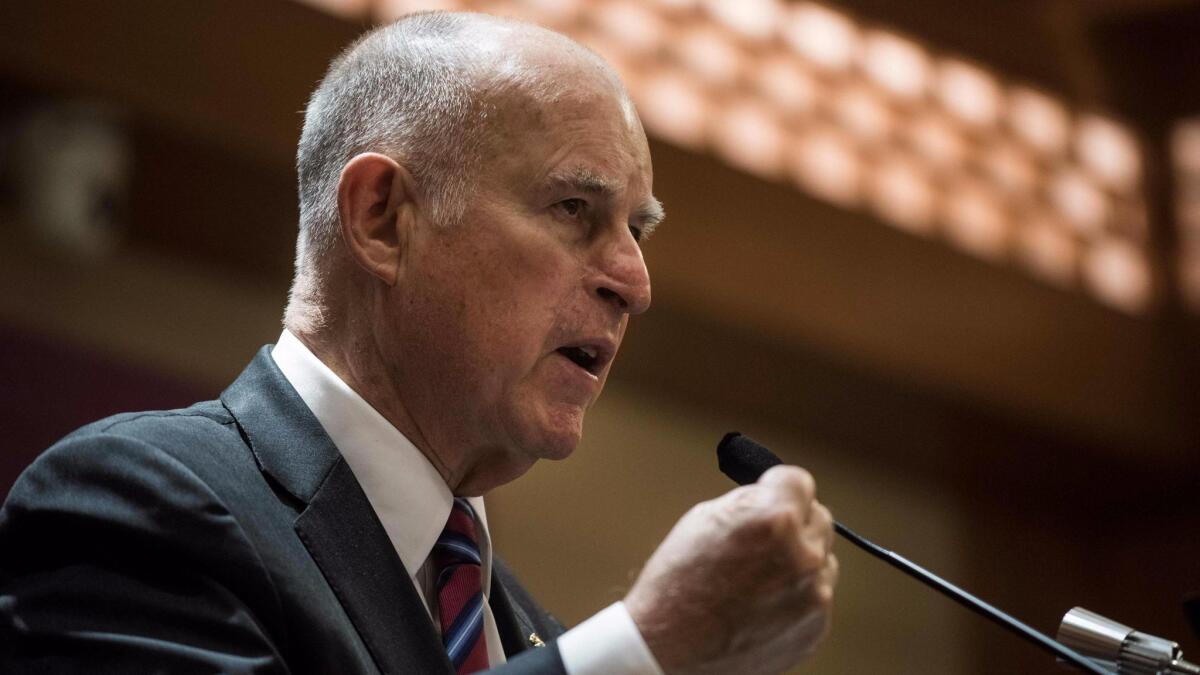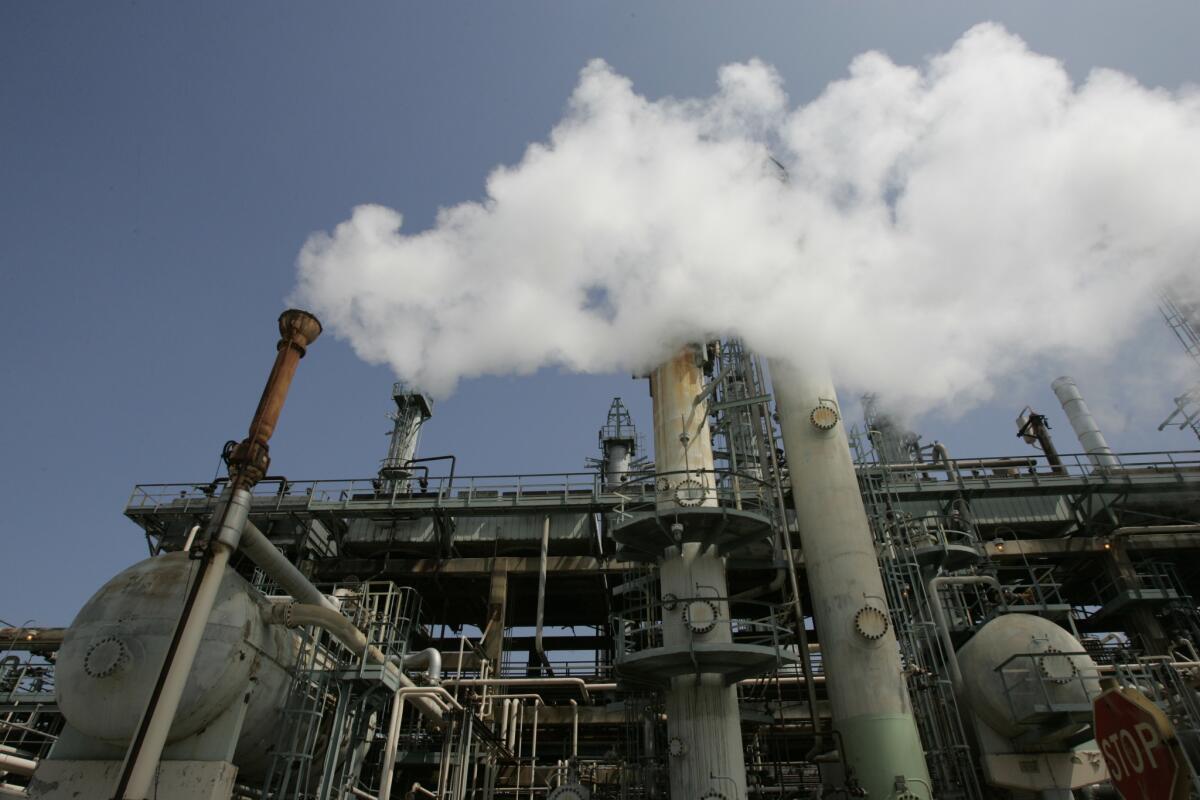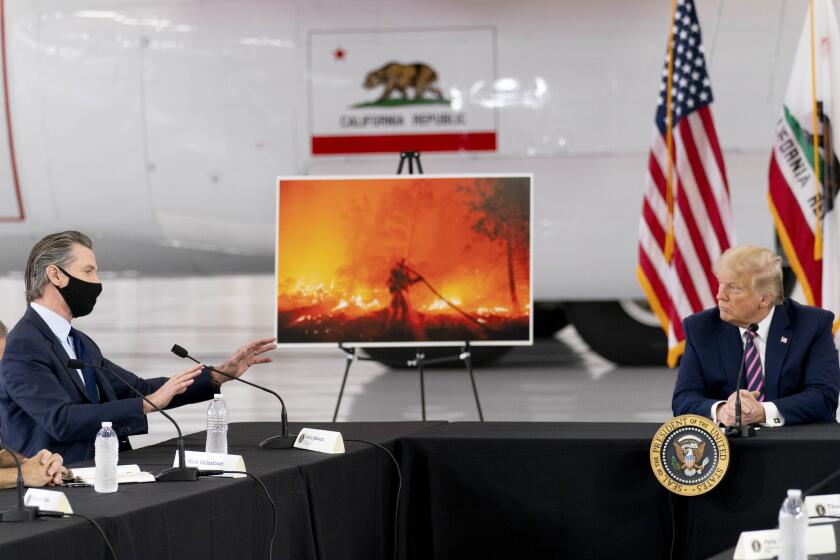California’s climate debate heats up behind closed doors as Gov. Brown pushes to extend cap and trade

The end of annual budget negotiations usually brings a sense of calm to the Capitol, but behind the scenes Gov. Jerry Brown has intensified his efforts to reach a deal with lobbyists and lawmakers on a blueprint for California’s future climate change policies.
An agreement to extend the state’s landmark cap-and-trade program, which requires companies to buy permits to release greenhouse gas emissions, may not be possible before the end of next week — the governor’s original goal for resolving its fate. However, Brown’s advisers believe they can seal the deal in July, and negotiations escalated this month after a previous effort stalled in the Assembly.
The governor’s office has hosted a steady stream of meetings this week with advocates from environmental and industry groups, as well as various factions of legislators. Brown made a rare visit to the offices of Assembly Speaker Anthony Rendon (D-Paramount) and Senate leader Kevin de Léon (D-Los Angeles) in an attempt to overcome their reluctance to push the issue on the heels of another contentious vote to raise the state’s gas tax.
At the same time, legislators, particularly those in the Assembly, have held their own confabs to stake out negotiating positions. Even some Republicans are involved, working with moderate Democrats on a series of business-friendly priorities such as using state funding to help the agriculture industry reduce emissions with cleaner equipment. Meanwhile, a progressive cadre of Democrats have pushed the governor to address the state’s affordable housing shortage.
“We are not close,” De Léon said Wednesday. “We still have to do a lot of hard work.”
The governor’s office has been developing draft proposals and circulating them in the Capitol, and several have been reviewed by The Times. Although the documents have not been publicly released and details remain in flux, they’ve provided the foundation for negotiations among environmentalists, labor leaders, industry groups and utilities — all of which have a stake in California’s climate policies.
Provisions favored by oil companies have been particularly divisive, including one idea that would limit regulations on refineries.
After a Wednesday meeting with Rendon, Brown demurred when asked about the proposals floated by his administration.
“Can’t talk about it,” he said.
The governor is eager to finalize a deal as he contrasts California’s environmental leadership with President Trump’s decision to withdraw from the Paris accord on fighting global warming. Brown has also ramped up his efforts on the international stage, gaining a role as a “special advisor” at the next United Nations conference on climate change later this year. He recently traveled to China, where he met with President Xi Jinping to discuss increased cooperation.
“Since the governor returned from his trip to China, he’s exerted his leadership directly,” said Rob Lapsley, president of the California Business Roundtable. “That’s dramatically helped the conversations move forward.”
Nancy McFadden, a top aide to the governor, said “it’s going to take a bit longer than we would have liked” to reach a deal and that they’re aiming for a vote on extending cap and trade in early July.
Follow live coverage from the Capitol on Essential Politics »
The ongoing talks are aimed at reaching a two-thirds vote in each house of the Legislature, a high threshold intended to insulate cap and trade from future legal challenges.
Much of the debate is focused on reducing greenhouse gas emissions that contribute to global warming, but slashing pollution in disadvantaged communities has also been an essential part of the negotiations.
A draft of the governor’s proposal would boost monitoring of air pollution to better determine where issues need to be addressed. The California Air Resources Board and local air districts would be responsible for developing neighborhood-level plans to mitigate the problems, a more localized approach than regulators currently employ.
The plan is geared toward addressing the concerns of environmental justice advocates, who are focused on alleviating pollution to improve public health. Amy Vanderwarker, co-director of the California Environmental Justice Alliance, said her organization “has been encouraged” by the conversations, but wants to make sure that any measure includes “real teeth.”

The governor’s draft proposal would extend the cap-and-trade program — the only one of its kind in the country — until 2030 and modify its operations.
Among the changes would be a cap on the price of emission permits, although the exact level is still being debated. The idea has concerned some advocates who fear the state’s focus on managing prices would detract from its ability to ensure emission reductions.
“We’re very concerned about some of the discussions in the Capitol,” said Fred Krupp, president of the Environmental Defense Fund, an organization that’s been among cap and trade’s most vocal promoters.
During a recent panel discussion in Sacramento, McFadden said the administration was dedicated to making sure that cap and trade remained “environmentally effective.”
Another controversial part of the talks is a provision that would benefit oil companies by limiting the Air Resources Board’s ability to regulate refineries. The board had proposed requiring refineries to slash their greenhouse gas emissions by 20%.
Local air districts would also be prevented from creating another level of rules on greenhouse gases from refineries and other industrial facilities, a step that Bay Area regulators have considered.
Finding the right balance between environmental and industry goals will be an ongoing challenge for negotiators.
“We still want to land this plane, but right now the runway looks a little too oily,” said Alex Jackson, a San Francisco-based lawyer for the Natural Resources Defense Council.
Hanging in the balance is revenue from the cap-and-trade program, which has ranged from several million dollars to more than $1 billion in recent years.
Negotiations haven’t yet centered on how the state would spend the money — some of which Brown is counting on for building the bullet train, the largest infrastructure project in the country.
Money has also been spent on projects intended to reduce greenhouse gas emissions, such as mass transit and electric car rebates.
Lawmakers leave for their summer recess on July 21.
[email protected], [email protected]
Twitter: @chrismegerian, @melmason
ALSO
A new proposal on California’s cap-and-trade program emerges as vote is delayed
California sees a rebound in cap-and-trade auction, bolstering key climate change program
Updates on California politics
More to Read
Get the L.A. Times Politics newsletter
Deeply reported insights into legislation, politics and policy from Sacramento, Washington and beyond. In your inbox three times per week.
You may occasionally receive promotional content from the Los Angeles Times.












